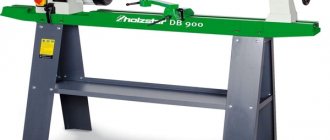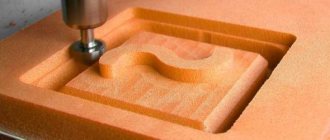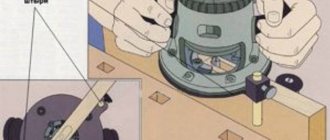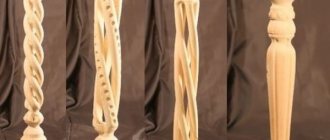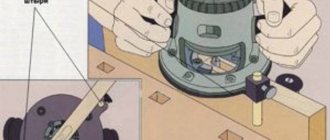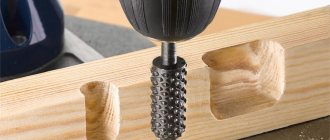SHARE ON SOCIAL NETWORKS
FacebookTwitterOkGoogle+PinterestVk
From this article you can find out what a cutting element such as a wood cutter for a hand router is. The text sets out a detailed classification of products: the main types and features of parts, their technical characteristics and practical use. The article contains useful recommendations that will help you decide on the choice of cutters for hand tools.
Milling cutters for hand routers are presented in a wide variety on the modern market, which makes it possible to choose the right tool to perform specific technological operations
The principle of the structure of cutters
Despite the variety of types that can be found in stores, they all have a common type of design.
There are two main parts of the design:
- shank;
- Workspace;
The first is installed in the router chuck and is designed to transmit torque.
The work area is where the blades are. This part can be straight or with an original shape. This determines what kind of work a particular tool is suitable for.
The cutter may include additional elements, such as bearings, screws, washers, calibration bushings, locking couplings. They are needed to make work easier or to expand functionality.
Additional equipment
Additional equipment of a router greatly influences both its functionality and price.
Therefore, the closest attention must be paid to the completeness and quality of equipment. Even if a router is purchased for a specific purpose, it would be useful to find out whether there is additional equipment for this model and whether it is possible to attach equipment from other models to it
The parallel stop is designed to guide the cutter at a constant distance from the edge of the part. With the help of this stop, grooves are milled in furniture facades, interior doors, etc.
The guide rail is also designed for milling along straight lines, but, unlike the rip fence, it is not tied to the edge of the workpiece. The guide rail allows you to mill at any distance from the edge and at any angle to it.
The copying sleeve is used to copy a part according to a template. The bushing is selected according to the diameter of the cutter and is installed in the sole above the cutter. The template is placed on the material being processed, and by pressing the sleeve against the edges of the template, it is copied.
The compass allows you to mill along a radial line.
Main characteristics
Milling cutters have their own characteristics that you should pay attention to.
Shank diameter
Depending on the size of the cutter, various clamping elements for the shank are manufactured. First of all, you should check in what units of measurement the size of the latter is indicated - in inches or millimeters. If the units of measurement between the shank and the clamping element do not match, problems will arise that will reduce the life of the router and reduce the quality of work.
Length of cutter and cutting base
The normal length of the cutter is considered to be 60-210 mm, the cutting base is 15-125 mm. Long tools have increased parameters: 105-250 mm and 55-140 mm, respectively. They are mainly used for roughing. Short cutters are used for working with various materials and roughing. Their sizes: 60-205 mm for the cutter, 15-120 mm for the cutting part.
Alloy
Type of alloy used to make tools:
- solid carbide;
- carbide-tipped alloy.
The main characteristic of solid carbide is maximum precision when working with wood.
Carbide-tipped alloy parts are equipped with cutting parts of various shapes, thereby increasing the range of tasks performed. They need to be sharpened less often than representatives of the first option, but the sharpening process itself is more complicated.
Chip removal
There are different types of waste disposal:
- Single-pass with chip removal upwards.
- Double-thread with chip removal upwards.
- Three-start and four-start with chip removal upwards.
- With chip removal downwards.
- With straight knives.
The first type features one edge and a groove. The chips do not melt or stick to the tool.
The latter are designed for high-precision processing due to their rigid structure. The cut is smooth and clear.
Still others are characterized by a large number of working edges, which increases the speed of work to the maximum.
The fourth ones are suitable for working with single-layer material. Due to the special impact on the material from above, these cutters eliminate the need for locking elements so that the product remains in place during the process.
Fifth ones are used when working with multilayer materials. Well suited for punching grooves.
To prevent rapid wear, cutters should be used in the types of work for which they are intended.
Purpose of a hand router
As an example, we can consider the milling machine DIOLD MEF - 1.1.
A fairly portable and multifunctional tool, used for processing various lumber. Most experienced carpenters know that a router can also replace a hand jigsaw, plane, or saw. With its help, you can easily install hinges on an entrance or interior door, insert an internal lock, and also make picture frames and make various drawings.
For a more global use of the tool, you need to familiarize yourself with the classification of cutters. Each cutting element has a shank diameter. You should pay special attention to this when purchasing. A hand router has different collet diameters for the shank, which can be either short or long. Some of the most common are 6, 12, 8, which is quite enough for a home workshop. It is necessary to remember that the larger the collet, the larger the cutter can be inserted into it, which will affect the diameter of the workpiece. The router of this model has an 8 mm collet.
As a rule, milling cutters with a collet diameter of 12 mm are quite powerful, and the price is correspondingly more expensive. Before purchasing a power tool, you need to decide for what purpose it is being purchased.
Types of cutter designs
The following types are distinguished:
- prefabricated ones are easy to manufacture and the most popular. They are elements of the cutting part welded to a steel base;
- with replaceable edges - this type can be used longer due to the ability to turn the double-sided blade over when it becomes dull;
- monolithic - they are a single piece of metal in which the cutting part is cut out. The inability to break a knife in such a cutter is compensated by the need to replace the entire part after several sharpenings.
Kinds
To perform a particular operation, an appropriate cutting tool is installed in the machine chuck. For a manual milling cutter, various designs of end mills are used, which are a shank with a diameter of 6.8 or 12 mm, and a working part with cutting edges. There are various designs with specific capabilities. Let's look at the types of cutters and their purpose.
By type of design
Varieties of the general design of cutting tools:
- prefabricated They consist of a shank and a steel blank onto which the cutting edges are rigidly attached. They provide high quality processing and require virtually no maintenance. The disadvantage of such a tool is the possibility of chipping or breaking off the cutting edges from the base. Can be used for the manufacture of furniture facades;
- with replaceable edges. Designed for mass production, in which the cutting part quickly becomes dull or fails. The rest of the tool is quite functional, so it is advisable to change the blade and continue working. Typically, double-sided edges are made that are reversed as they fail. It is also possible to completely replace the cutting part;
- monolithic. This type of tool is made from one piece. They have high strength and resistance to loads, but the service life of such cutters is relatively short. They do not allow overheating; work at high speeds or blunt edges quickly damage the tool.
The vast majority of commercially available tools are prefabricated. They are inexpensive and have a long service life. Cutters with replaceable edges are less common, as working with them requires some skill and experience. In addition, they are noticeably more expensive than prefabricated types of tools, which limits demand. Monolithic samples are used for processing hard materials and require compliance with certain rules and cutting conditions. Sharpening such cutters is a difficult task and requires experience, so most home craftsmen try not to use them.
By blade type
Blade configuration is a factor that determines the cutting behavior of a material. Straight-edged cutters operate on the principle of planer blade shafts and cut down a specific layer of material. Spiral edges cut the surface, resulting in a cleaner finish but lower productivity. According to the type of metal, the blades are:
- high-speed;
- carbide.
The first type is designed for processing at high speeds. A special type of metal is used - high-speed steel, which is produced specifically for the manufacture of tools. The second type of blade is made for processing hard types of material. They are more fragile, the price of such an instrument is noticeably higher. The highest quality blades are virtually impossible to sharpen using conventional methods, but are capable of cutting the hardest materials. It is recommended to operate them at relatively low speeds.
Types of cutter blades
When examining cutter blades for a manual wood router, the following types and types are found:
- knives made of high-speed steel. Marked with the letters HSS. It is necessary to choose when working with soft wood;
- knives made of carbide metals. Marking – HM. Mainly used for working with hard materials. Durable and resistant to elevated temperatures.
In addition, there are a number of varieties of blade shapes:
- vertical;
- inclined;
- spiral.
Inclined ones provide a better quality end result by cutting pieces of wood rather than chopping down, as vertical knives do.
Additional equipment for manual milling machines
As a rule, hand-held milling cutters come with various guides and other auxiliary devices, but if they are not enough, you can always purchase them separately or make them yourself.
The presence of additional equipment expands the functionality of the tool
Additional accessories for hand routers include stops and a guide rail, a copy sleeve and an angular stop, as well as a compass ruler. Parallel and horizontal stops allow you to process workpieces at an equal distance from the edge (edge) of these elements, and the guide rail serves for linear movement of the router. The copying sleeve is a round plate, equipped with a side, inserted into the opening of the support platform and providing support around the working cutter. An angular stop is used when making a copy of a finished product, and a compass ruler helps to process workpieces along a certain radius.
We advise you to study - Installation of plastic windows according to GOST - detailed instructions
The copy bushing for the router is a stamped product
Grooving cutters
Designed for creating grooves, grooves and forming decorative surfaces in workpieces. There are several types of goods on the market.
Direct
A simple piece in the shape of a cylinder. Can be used:
- like a drill bit;
- to create grooves;
- for splicing workpieces;
Fillet
Designed to create fillets - semicircular recesses that can be located in the edges, main planes and ribs. They have a shape similar to the "U" symbol. They can create recesses of increased complexity to decorate the workpiece. They are distinguished by high quality and reliable results.
V-shaped fillets
They differ from the previous type in the shape of the tip, which is made in the shape of the letter “V”. They come in handy when you need to create grooves at different angles.
Structural (T-shape and dovetail)
Used to create T-slots. “Dovetail” is another subspecies of this type, which is used for the same purposes, but is slightly different in shape. A lot of experience is required to operate these tools. Grooves made using such a tool are considered one of the best ways to connect wooden parts to each other.
Shaped
Suitable for creating the most complex planes and grooves. The grooves are shaped like braces. Created according to the requirements of a specific customer. They are used to solve various specific problems. They have a large working resource. Allows you to reduce the amount of time required to work with the workpiece.
When creating a complex pattern, you can first go along the contour with a straight phase cutter to simplify the process.
What it is?
In terms of design, the milling machine is extremely simple.
All its versatility is due to the capabilities of the cutting tool and equipment.
During axial rotation at high speeds, the working edge comes into contact with the surface of the part and cuts off a layer of material of a certain thickness.
Using various devices and working techniques, milling operators obtain results of high quality and accuracy. The tool is plunged into the workpiece and forms a recess corresponding to its configuration and dimensions.
The main advantage of a manual milling machine is the simplicity and safety of processing large parts and areas. Stationary machines are designed to work with steel workpieces, but manual machines are designed for processing softer types of material:
- wood of different types;
- Chipboard, laminated or regular;
- MDF, fiberboard, plywood;
- aluminum;
- soft types of plastic.
Most cutters have several working surfaces and are capable of performing their functions when feeding the workpiece in different directions. On stationary machines the workpiece moves, manual milling cutters themselves move along the surface of the workpiece, but this does not change the general principle. The range of functions available to manual machines is much wider than that of stationary equipment. The arsenal of manual milling cutters includes the following operations:
- edge processing;
- making grooves or ridges;
- creation of decorative elements, relief ornaments;
- copying parts of various shapes and configurations;
- production of sockets for fittings, mechanisms, handles and other furniture components.
This is interesting: Shaped turning cutter - types, GOST, markings, drawings
Edge cutters
They are a cutting tool for working with edges and creating the desired shape. The following types of such parts can be distinguished.
Direct
Simple and common, these cutters produce flat, straight, perpendicular type edges. The version with a bearing makes it possible to work with round shapes.
Mouldings
The goal of this type is complex patterns. Consist of two cutting parts. Suitable for straight machining, smooth bends and rounding.
When choosing this type of cutter, it is recommended to take those that are equipped with the ability to adjust the distance between the cutting elements.
Folded
Suitable when you need to make rectangular grooves on curved or straight parts. They make it possible to obtain the result of the desired shape through a double pass.
Conical
A special type used by furniture manufacturers. Used for processing parts before joining. By changing the angle of inclination of the cutting part, decorative chamfers are achieved for connecting products of polygonal and round shapes.
Fillet
Used when you need to make a rounded groove. Equipped with two bearings that protect the tool from distortion. The result is similar to that obtained with groove fillet cutters, but edge cutters are sometimes more convenient.
Curly
Characterized by heavy weight. Used on large professional machines. They speed up the process by working over the entire area of the product. You can combine different elements.
Half-rod
Used to create semicircular protrusions on edges. Transform rectangular blanks into rods. You can make chamfers and edges of complex shapes and hinged joints. To do this, you will have to, along with a half-rod cutter, process the part with a fillet or molding tool.
Finger and solid cutters for grooving
Milling cutters without bearings are usually called slotted cutters. Some of them have edges that close at the bottom end, some are equipped only with end knives, like a Forstner drill. With such cutters it is possible to enter with a vertical feed of the router, and therefore they are ideal for cutting out lugs and blind grooves.
Cutters with side edges make grooves and grooves only starting from the edge of the workpiece; sometimes they are used for copying according to an internal template and making carpentry joints. Most cutters of this class are monolithic; their shape can be:
- rectangular;
- trapezoidal;
- fillets;
- wedge-shaped;
- shaped with a more complex shape of cutting edges.
Spiral cutters are ideal for cutting blind grooves with a vertical entry, since their helical edges remove chips well, significantly increasing the speed of work. Spiral cutters are considered faster cutting than conventional cutters, but have a rather meager selection of profile shapes. However, fillet, trapezoidal and V-shaped grooves are cut much faster with their help.
We advise you to study - How to sharpen a victorious drill
A special type of groove cutters can be called rosette cutters, designed for cutting radial patterns of complex shapes. You can work with them either with a point immersion or according to a template, leaving a groove with equal shaped sides. Also keep in mind that almost all types of end mills can be used for edge processing, either by trimming or to the end using a special stop.
Combined cutters
Used to combine parts along the end or edge. In addition to the main purpose, they also grind and expand the surface. To choose the right type of cutter, you should familiarize yourself with the subtypes.
Combined universal
They create a junction of two parts with a groove and a tenon. They save time due to the ability to process both workpieces being combined without changing the attachment.
Tongue-and-mortise
They differ from the previous version in that the groove is on one of the workpieces being connected, and the tenon is on the other.
For the manufacture of lining
The purpose is the same as in the tongue-and-groove version, with the difference that shaped recesses are created for a more reliable connection.
Combined frame
Bearings, knives, retainer and washer are located on the same base. Used in multi-complex works. When working with this type, a specialist can arrange the cutting blades in an order convenient for him.
How to make accessories for a wood router with your own hands - nuances
If you can buy additional equipment necessary to perform certain work, then it is better to make a milling table for a manual milling machine yourself
In this case, in order to avoid errors during manufacturing, it is necessary to pay attention to some nuances that should be taken into account when performing work:
- Before starting work, it is necessary to draw up a drawing (sketch) of the object being constructed.
- Regardless of the materials used, the assembled table must be durable and stable on the floor surface.
- Due to the fact that the router is attached to the bottom of the tabletop, it is necessary to provide access to the device for cleaning it and performing other preventive maintenance.
Sketch of a table for a manual milling machine, which you can make yourself
- The presence of a metal ruler located at the ends of the table will simplify setting dimensions when used.
- For convenience and the ability to quickly turn off the router in case of unusual situations, you can install an additional control button directly on the table surface (emergency button of the “mushroom” type).
Figurine cutters
Used when necessary to make shaped chamfers and decorative edges. The bearing makes it possible to use shaped and rectangular workpieces. There are three subtypes of cutters.
Horizontal
Used for processing panels. Including decorative ones. Thanks to the bearing, you can work with straight and curved edges.
Horizontal double-sided
They reduce processing time due to the ability to perform in one pass, immediately creating a shaped part and a tenon for the groove.
Vertical
The most common application is the creation of skirting boards. Although the capabilities of these cutters are not limited to this. The result of the tool is a decorative part and a tenon joint.
Having studied the types of wood cutters for a manual router, you can go to the store to choose the appropriate option and get to work. And all the variety of options will allow you to do any job that you can think of.
How to choose?
First of all, you should find out in advance what types of cutting tools are needed, their type, edge shape, presence of bearings and other features. When purchasing, you should decide for what purpose the cutting tool is needed, what volumes of work are planned to be performed, and how hard and dense the wood needs to be processed.
Based on these factors, one or another type of cutter is chosen. If you need to buy an expensive sample, it is recommended to ask the seller for a certificate of conformity, since there are a large number of fakes from Southeast Asian countries on the market.
If there are any problems with the provision of documents, you should look for the necessary cutters elsewhere. The number of instruments on the market is huge, finding a high-quality sample will not be difficult.
Brief conclusions:
There are many different cutters that allow you to process and produce wooden parts of any complexity and any shape.
For tools to last a long time, it is important not only to use them correctly, but also to properly care for them. The main condition for their long-term operation is the complete exclusion of contact with a damp environment. If after prolonged use the cutting edge has become dull, it can be sharpened. It is recommended to do this procedure no more than three times so as not to change the shape of the edge.
When purchasing tools, you need to take into account that each cutter is designed for only one type of processing. If you are planning a variety of work, you should buy the appropriate set of wood cutters.
Parameters for dividing products into types
It is quite common to do woodworking at home, especially for residents of private houses. In such work, a hand router makes it possible to perform a lot of tasks, especially if you know which cutter to use for what. Today, types of woodworking products are divided according to the following parameters:
- Tail size.
- The material from which they are made.
- Shape, location and types of blades.

